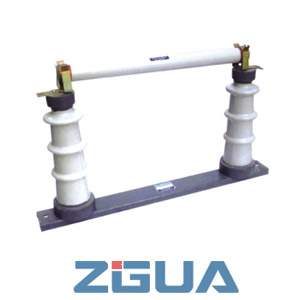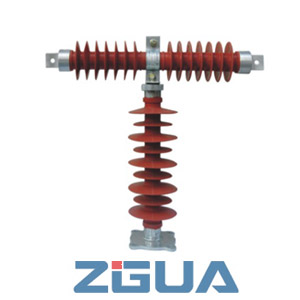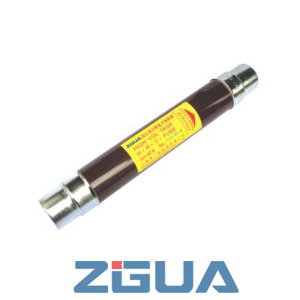The structure and use of commonly used high-voltage fuses
1) RN-type indoor high voltage current limiting fuse
Commonly used indoor high-voltage fuses, taking the RN1 series and RN2 series products as examples, are quartz sand-filled sealed tube fuses.
(1) RN1 series fuse
RN1 series fuses are mainly composed of fusion tubes, melt, brass end caps, quartz sand, etc. The melt is one or several parallel filaments made of copper, silver, or constantan. Melts with a rated current less than 7.5A, depending on the rated current, are made of one or several silver-plated copper wires wound around a porcelain core, and a small tin ball is welded in the middle of the melt; rated currents greater than 7. The 5A melt is made of two copper wires of different diameters in a spiral shape, with small solder balls soldered at the connections. A steel indicator melt is installed in the melt tube, and its lower end is connected to the indicator. When the melt melts, the indicator is pushed out by the spring. It is suitable for overload and short-circuit protection of 3~35kV power lines and power transformers.
(2) RN2 series fuse
The structure of the RN2 series fuse is basically the same as that of the RN1 series fuse, but the RN2 series has only one fuse and no blow indicator. It is suitable for short-circuit protection of 3~35kV voltage transformers. During operation, it is judged whether the melt is melted according to the indication of the voltmeter on the secondary side of the voltage transformer.
2) RW-type outdoor high voltage drop fuse
Commonly used outdoor high-voltage fuses, taking RW4-10 and RW9-35 products as examples, are quartz sand-filled sealed tube fuses.
(1) RW4-10 outdoor drop-out high-voltage fuse
During normal operation, it is connected in series in the line. After the movable contact at the lower part of the fuse tube is tightened by the fuse tension, it is pushed into the upper static contact and locked into the closed position. When a line fault occurs, the fault current causes the fuse to melt rapidly, forming an arc. The arc-extinguishing tube decomposes a large amount of gas due to the high temperature of the arc, which creates a large pressure in the tube and forms a strong longitudinal arc blow along the pipeline, which causes the arc to be rapidly elongated and extinguished. After the fuse is blown, the lower contact of the fuse tube loses tension and turns downward, releasing the locking mechanism. The fuse tube turns over and falls under its own weight and the elastic force of the contact, causing an obvious disconnection gap. This drop-type high-voltage fuse adopts a "step-by-step exhaust" structure. In order to prevent water from entering, the upper end is closed during normal operation. When breaking the small fault current, the upper end is closed to form a single-end exhaust, which maintains a large pressure in the tube to blow out the arc generated by the small fault current. When breaking a large fault current, due to the large air pressure generated, the upper end is opened and the two ends are exhausted, which not only effectively blows out the large and small arcs, but also effectively prevents the fusion tube from being damaged by large mechanical pressure.
(2) RW9-35 outdoor current-limiting fuse
RW9-35 outdoor current-limiting fuse is composed of a fuse tube, porcelain sleeve, terminal cap, fastening flange, rod-shaped support insulator, and other parts. The fusion tube is installed in a porcelain sleeve, and the melt is installed in a fusion tube filled with quartz sand filler. It has the advantages of small size, lightweight, good arc extinguishing performance, large current interruption energy, strong current limiting ability, easy maintenance, and replaceable melt, which can improve the operational reliability of the power system.
Main parameters and characteristics of high voltage fuses
1) Rated voltage
It refers to the voltage that the high-voltage current-limiting fuse withstands for a long time after it is broken, which is generally equal to or greater than the rated voltage of the equipment or line.
2) Rated current
The rated current of the fuse and the melt refers to the current that passes through it for a long time. Generally, it is 1.5~3 times the rated current of the equipment.
3) Rated breaking capacity
It refers to the ability to reliably interrupt overload or short-circuit current under fault conditions. Generally expressed by breaking current or breaking capacity.
4) Insulation level
Generally expressed by power frequency withstand voltage and lightning impulse withstand voltage.
5) Ampere-second characteristics
It refers to the relationship between the action time of the high-voltage current-limiting fuse and the current passing through the fuse, which is provided by the manufacturer.








